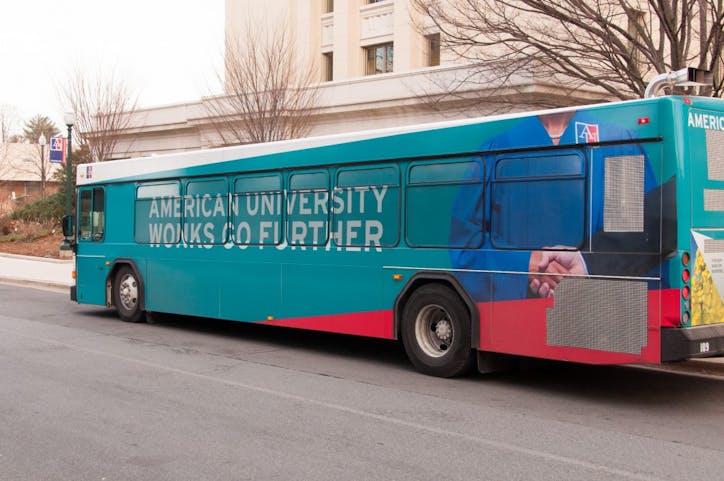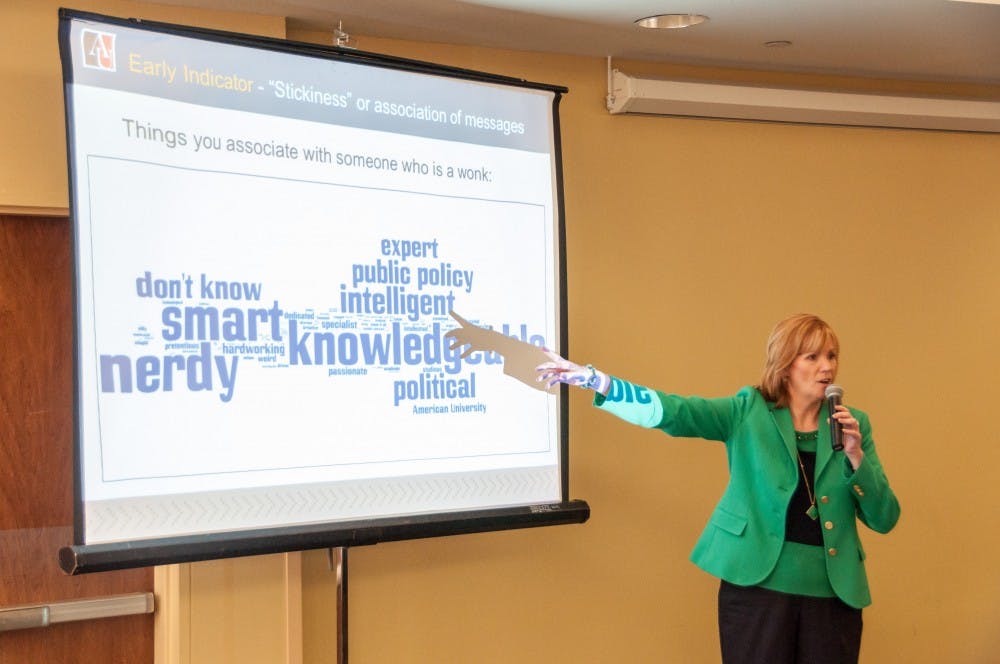Wonk Cat. Wonk Bus. Wonk of the Year. The term “wonk” is more than just a branding campaign for American University students these days—it’s a lifestyle.
Students can often be seen walking around campus wearing navy blue crew necks with “WONK” emblazoned across the front. They were designed by Zach Avis and Amelia Crabtree, two AU seniors who thought it’d be funny to create sweatshirts that resembled the similar Yale University typography. What started out as a joke quickly morphed into a business opportunity that has acted as a way for students to creatively express themselves through WONK merchandise.
When reflecting on his time at the University, Avis said that WONK became synonymous with AU since the beginning.
“We really liked the WONK campaign that we had when we were applying to the University,” he said. “When you’re thinking of AU, you’re thinking of WONK.”

A wonky history
It wasn’t always this way, though. When the WONK campaign first launched back in 2010, it was known as the KNOW/WONK campaign and emphasized the fact that university members (or “wonks”) knew their fields forward and backwards, the same way “wonk” spelled backwards is “know.”
The concept was largely developed by Teresa Flannery, vice president for communications at AU, and her colleagues in 2009. Flannery said that back then, she and the communications team surveyed 12 research groups consisting of students, faculty and higher education peers to better understand people’s perceptions of AU.
Flannery said the team created a brand strategy based on those responses that made it easier for the University to set goals and outline what the campaign needed to achieve.
They settled on five major goals, which consisted of raising awareness of AU’s location and character, helping the University stand out from its competitors in the D.C. area, improving perceptions of the University’s academic quality and reputation, informing and engaging alumni and raising awareness and influencing the perceptions of AU’s higher education peers.
To meet these goals, the WONK campaign is made up of three brand pillars: portraying active citizenship, learning from leaders and using Washington as a powerful tool for learning. These brand pillars continue to provide a foundation for the WONK campaign today, offering what it means to be a “wonk” at its core, even after the campaign’s strategy was re-evaluated in 2013 and 2018.
After the KNOW/WONK phase, the campaign shifted to a “Stories of Impact” phase in 2014, in order to attract more graduate students.
“It was important for the schools to tell prospective graduate students sort of what they would gain by coming to school here,” said Julia Zito, assistant vice principal for marketing at AU.
The new version highlighted stories of faculty and alumni in the AU community who were “wonks” doing great things in their respective fields.
“It got to the point where people really wanted us to tell more individual stories about people who represent this kind of character,” Flannery said.
Not everyone is a fan of the WONK campaign, however. Kyle Dargan, a professor in the College of Arts and Sciences’ literature department, said that he finds the WONK campaign to be a narrow view of what students can achieve by coming to AU.
Dargan said that AU doesn’t just produce wonks but also more of the “cultural workers” that Washington needs. He said D.C. is not just a “wonky” city, but a creative one.
While wonks are needed in government agencies, there also needs to be people out in the field that get information from them, Dargan added.
“We’re trying to teach people how to take information, and, more importantly, do interesting things with it,” he said.
Although some say that the WONK campaign may not be taken as seriously among the student body as the University wants it to be, data from the communications department suggests that WONK does work.
According to branding strategy data from the university communications team, in the 2009-2010 benchmark year of WONK, only 44.7 percent of students said AU was their first choice institution. In 2016, it went up to a peak of 61.2 percent of students saying AU was their first choice. That measurement went down to 55.3 percent in 2017, but went back up to 58.3 percent a year later.
Getting creative
When it comes to creatively reinventing the WONK campaign, students can’t get enough of it. “Wonk”-themed memes are regularly posted on the student-run meme group, formerly titled “AU Memes for Wonky Teens” and currently called “AU Memes for Red Line Disenfranchised Teens.”
The page’s cover photo insinuates a debate over who would win in a fight: Wonk Cat, AU’s unofficial mascot that lives in a makeshift house near SOC, or Wonk Rat, the rat that was spotted in Megabytes and resulted in the cafe’s closing.
One student created a “wonk” bingo card that feature aspects of AU campus culture that only AU students would understand, with spaces filled with phrases like: “has eaten lemongrass chicken three times a week,” “has never been to a single sporting event” and “ran out of EagleBucks within the first month.”
“It’s become more of a community thing as opposed to something that the University is behind,” Crabtree said, crediting the meme group for increasing awareness of the campaign.
Similar to Avis and Crabtree, other students have found ways to profit from the brand, including sophomores Will Goldman and Frank Piscani, who co-run their Instagram account “A Subway Series of Pics” and create “SubWonk” stickers that can be found around campus.
The students said they created the account to combine what they considered to be the “two most important pillars of AU”: the WONK campaign and Subway. They sell stickers on the site RedBubble and in person by having students send them money through Venmo, a mobile payment service. The two students plan to use the profits on an event surrounding “A Subway Series of Pics” to give back to the AU community.
Piscani said that WONK has helped shape campus community since it’s “so easily identifiable.”
“To tie ourselves to [the campaign] I think was…a way we felt we could become integrated in the community and draw close ties to the students who we try to represent and bring together as a community,” Piscani said.
Daniel Ward, a freshman in the School of Public Affairs, owns one of the “wonk” sweatshirts created by Crabtree and Avis. Ward said he found an instant connection to the campus through the WONK campaign since it provides everyone with a “shared sense of humor.”
He doesn’t think the term “wonk” is taken seriously among the student body, but that’s not necessarily a bad thing.
“I wouldn’t talk about myself being an ‘AU Eagle,’ like, ever,” Ward said. “But I would definitely talk about ‘wonk’ because I think it’s funny.”

The uncertain future of WONK
Although WONK has made an impact on the AU campus community, there are no definitive plans as to where it will go in the future.
“We don’t know yet,” Flannery, who is stepping down from her position in June, said. “I think it’s fair to say that we expect that there will be some [more] evolution of the campaign.”
There is a need to “refresh the expression of the university’s brand,” based off of 2018 survey responses, but they are not exactly sure what the new elements of the campaign will be, Flannery said.
While the WONK campaign is not necessarily going away, Zito said that the communications team may move away from it slightly to explore other opportunities.
“I think WONK will always be a part of us,” Zito said. “There’s so much good about WONK that we don’t have to lose the essence of what that means to the students, but we don’t necessarily have to use the word.”
Flannery echoed these sentiments, stating that the marketing team found a unique way to describe the AU community.
“I think we put our finger on an idea that absolutely reflected who the people are at this university: the faculty, staff and students,” Flannery said. “It was authentically us.”
Some students expressed that the WONK campaign has become an integral part of the AU community that they don’t want to let go of. Piscani said that he would be “devastated” if WONK was removed from the AU campus.
“I think it really is a significant part of AU and its culture,” Piscani said. “I think all the students can identify with it in some way, whether it is seriously believing in what it means to be a policy wonk, or just loving the irony of it.”
This article originally appeared in The Eagle's March 2019 print edition.





